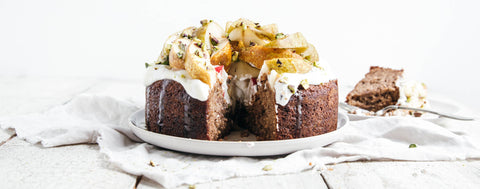Calcium is an extremely important mineral to the human body, where it is a vital structural component of our entire musculoskeletal system. So vital in fact, that 99% of our body's total calcium is found deposited within our bones and teeth. It is also involved in mediating the constriction and dilation of our blood vessels and plays a role in muscle contraction, signalling of nerve impulses, and hormone release.
So, what can we do to ensure our body is getting all of the calcium it needs?
Eat it!
Typically, dairy products such as milk, yoghurt, and cheese are the food group most commonly thought of for high calcium content. Fish with bone-in such as sardines and salmon are also highly ranked as a rich calcium source.
Calcium can also be found in abundance in many plant-based foods, as the minerals from the soil are pulled from the ground up into edible vegetables, fruits, seeds, grains, nuts, and legumes.
Here are 5 excellent plant-based sources of calcium you might not know about:
Tofu
Tofu tops the charts for calcium quantity per gram when compared to other foods, easily surpassing cow's milk for the top spot. This soybean-based product is also a great source of protein making it a great wholefood product for both vegetarians and vegans. Tempeh, a form of fermented tofu, is well regarded for its health promoting benefits by providing beneficial bacteria and is also comparable to plain Greek yoghurt when it comes to bone strengthening minerals.
There are many different ways tofu can be enjoyed whether fried, baked, or scrambled.
Sesame seeds
The humble sesame packs an impressive amount of calcium into its tiny seeds, along with other minerals. Whilst most of the calcium is stored within the hull, it is also present in the seed remaining underneath. To get the most out of your sesame seeds, it is first important to soak them for at least 8 hours to help neutralize phytic acid which is found mainly in the hull and impairs calcium absorption.
Tahini in its un-hulled form can make a great addition to salads, smoothies, and baking for an added dose of calcium. Sesame seeds are also delicious when added to any homemade nut milk, which once soaked overnight and blended with other nuts adds a creaminess and subtle aromatic flavour.
Cinnamon
This fragrant powdered spice is an unassuming yet, a rich source of calcium. Just 1 tsp of powdered cinnamon supplies nearly the same amount of calcium as ½ cup of cooked broccoli.
Cinnamon powder is a common staple in many household pantries and is frequently used in baking and cooking. Anywhere from ½-2 tsp of cinnamon can be stirred into smoothies, oatmeal, cereals, and hot drinks for a sweet little calcium hit.
Alfalfa
Alfalfa sprouts are a perfect addition to any diet looking to protect bone health as it contains calcium as well as significant amounts of Vitamin K. These two nutrients work synergistically, as Vitamin K helps transport calcium out of circulation and deposits it into the bone. Although the quantity of calcium per gram of alfalfa isn't on par with something like dairy cheese, the presence of Vitamin K acting as a chaperone for calcium makes it an ideal supplement for assisting proper bone mineralization.
Alfalfa sprouts are wonderfully nutrient-dense and versatile. A handful can easily be added to a sandwich, salad, or even blended into smoothies.
Nettle
Nettle (Urtica dioica) is a medicinal herb with a wide range of healing properties. The leaves of this plant are incredibly nutrient-dense and are packed with vitamins and minerals, including calcium, iron, and selenium. This plant however is often thought of as a pesky weed rather than a source of nutrition due to the hundreds of tiny stinging hairs covering its outer surface. Fortunately, the stinging hairs are easily neutralized by steeping the fresh leaves in boiling water, resulting in a safe to drink infusion. If fresh nettles aren't available to you, purchasing dried nettle leaf to use as herbal tea will also suffice.
To get the most nutrients from Nettle, prepare a large infusion that is left overnight. Simply:
- fill a large jar with the dried leaves (or fresh if you have) and cover the jar with boiling water.
- Stir so the nettle is completely submerged.
- Seal the jar with the lid and leave overnight.
- Strain contents and enjoy a cup of the liquid
- The remainder of the liquid may be kept in the fridge for 2 days.
A strong nettle infusion should be deep green-brown colour, as the minerals are liberated from the leaves into the liquid.
If you need help navigating your nutrition plan, talk to one of our Naturopaths in store.
-Article by Naturopath Kate Dalliessi




